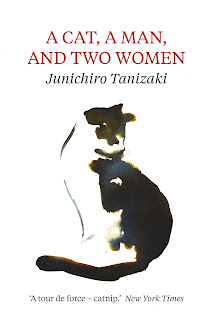Neko to Shōzō to Futari no Onna or A Cat, A Man and Two Women by Junichiro Tanizaki is a short novel that is a prime example of this feline devotion.
There are oodles of gorgeous descriptions of cats being cats, that any cat lover will know and love intimately - from cats snuggling up with you under the covers on a cold night, to stretching up to put their front paws on your thighs, begging for a tempting morsel of your dinner.
First wife, Shinako is banished in favour of the new wife, Fukuko, who cleverly professes her love for cats...that lasts as long as it takes her to realise how much time and how much attention Shozo actually showers on Lily.
Shinako decides to get back at Shozo by requesting Lily as part of her divorce settlement. Fukuko agrees to the arrangement, although she is then concerned that Shinako is only doing so to get Shozo to visit her, to see Lily, in the hope she can win him back. Such dastardly, manipulative actions by everyone concerned litter the entire story. And don't get me started on Shozo's ghastly mother trying to orchestrate herself into a financially comfortable retirement by bringing in a wealthier daughter-in-law.
All this is done so subtly and gently by Tanizaki, though, that you barely realise how awful they are until the very end. Lily is the shining star of this story - the only one with any integrity, who remained true to her own nature the entire time.
I suspect there are also some subtle conventions about Japanese society that Tanizaki was exploring here as well - Shinako's mention of her lack of education. The specific locales that each woman was raised in. Lily's status as a Western breed, "with soft, silky fur: a pretty female, unusually elegant in form and features". These are all typical Tanizaki themes according to Tony Malone, who says in WHO IS JUNICHIRO TANIZAKI? Quarterly Conversation published on March 12, 2018,
One of these is Tanizaki’s interest in the world outside Japan and his examination of the effect that foreign culture was having on the Japanese way of life at the time of writing...
Tanizaki was also an astute observer of differences within his country...
Tanizaki has one other recurring focus; even a cursory glance at his work will reveal an obsession with the erotic and the female form...
He is clearly a man of many faces: a serious writer with a fascination for tradition and the past; an observer of cultural differences, both internal and external; a man obsessed with women, at times denigrating them, but at others acknowledging their mastery over men; a writer always looking to experiment with a variety of styles and genres. Above all, though, Tanizaki is a man we may be unable to measure by means of his writing, as what we see is what he wants us to see.
Favourite Character: Lily of course
Favourite Quote:
A soft, velvety, furry thing began silently working its way under the top quilt. Lily pushed with her head, burrowing down to the foot of the bed where she roamed about for a while before climbing back up. Putting her head inside the breast of Shinako's nightgown, she stopped moving, and after a while began to purr, very loudly and happily.
My cat Maisie, used to do exactly the same thing.
Favourite of Forget: The adult characters were less than admirable, but Tanizaki's descriptions of Lily's behaviour were so delightful that any cat lover will be won over.
Facts:
- Tanizaki was born 24th July 1886 and died 30th July 1965.
- He was shortlisted for the Nobel Prize in Literature in 1964.
- He translated The Tale of Genji from old Japanese into the modern language.
- A Cat, A Man And Two Women was translated by Paul McCarthy
- The Tanizaki Prize was established in 1965 by the publishing company Chūō Kōronsha. It is awarded annually to a work of fiction or drama of the highest literary merit by a professional writer.
- 1910 刺青 Shisei "The Tattooer"
- 1913 恐怖 Kyōfu "Terror"
- 1918 金と銀 Kin to Gin "Gold and Silver"
- 1919 富美子の足 Fumiko no ashi "Fumiko's Legs"
- 1921 私 Watakushi "The Thief"
- 1922 青い花 Aoi hana "Aguri"
- 1924 痴人の愛 Chijin no Ai Naomi a.k.a. A Fool's Love
- 1926 友田と松永の話 Tomoda to Matsunaga no hanashi "The Strange Case of Tomoda and Matsunaga"
- 1926 青塚氏の話 Aotsukashi no hanashi "Mr. Bluemound"
- 1928–1930 卍 Manji Quicksand
- 1929 蓼喰う蟲 Tade kuu mushi Some Prefer Nettles
- 1931 吉野葛 Yoshino kuzu Arrowroot
- 1932 蘆刈 Ashikari The Reed Cutter
- 1933 春琴抄 Shunkinshō "A Portrait of Shunkin"
- 1933 陰翳礼讃 In'ei Raisan In Praise of Shadows
- 1935 武州公秘話 Bushukō Hiwa The Secret History of the Lord of Musashi
- 1936 猫と庄造と二人の女 Neko to Shōzō to Futari no Onna A Cat, A Man, and Two Women
- 1943–1948 細雪 Sasameyuki The Makioka Sisters
- 1949 少将滋幹の母 Shōshō Shigemoto no haha Captain Shigemoto's Mother
- 1956 鍵 Kagi The Key
- 1957 幼少時代 Yōshō Jidai Childhood Years: A Memoir
- 1961 瘋癲老人日記 Fūten Rōjin Nikki Diary of a Mad Old Man
Book 3 of #20BooksofSummer (winter)
I finished this book on the Monday of our Queens birthday long weekend, where Sydney enjoyed a glorious 22℃ winter's day.
Summer in Dublin reached 15℃!


Interesting, Brona.
ReplyDelete